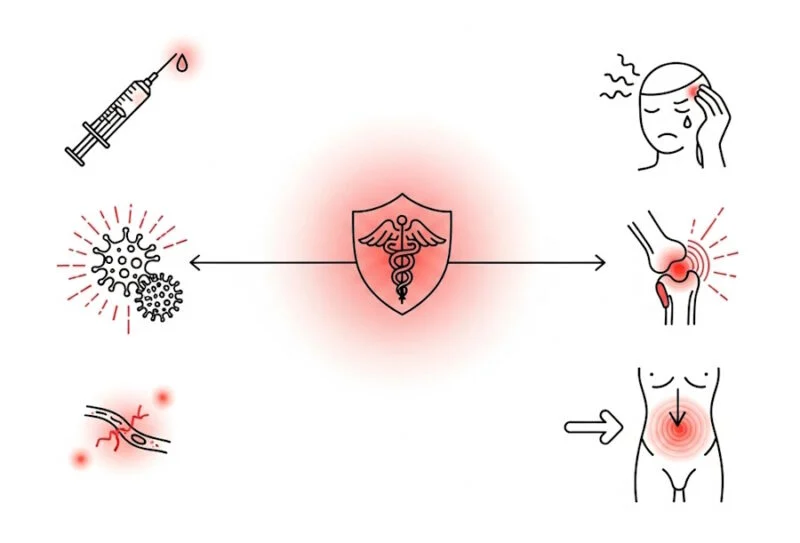General information
The Autoimmune/Inflammatory Syndrome Induced by Adjuvants (ASIA), also termed Shoenfeld’s syndrome, was first proposed by Israeli immunologist Yehuda Shoenfeld in 2011 as a unifying concept for various autoimmune phenomena potentially triggered by adjuvants—substances designed to boost immune responses without inherent immunogenicity.
Adjuvants are commonly used in vaccines (e.g., aluminum salts), silicone implants, fillers, and even environmental exposures. Since its description, over 4,479 cases have been documented globally, with a predominance in females (92.7%) and associations with vaccines like HPV and hepatitis B. However, ASIA remains highly controversial within the scientific community. It is not included in the International Classification of Diseases (ICD-10 or ICD-11), and critics argue it lacks definitive proof, with accusations of fueling anti-vaccination sentiments.
Epidemiological studies often fail to show increased autoimmune risks from adjuvants, and some reviews highlight biases in case reports, such as self-selection and inadequate controls. Despite this, ASIA has been discussed in dozens of peer-reviewed articles and international conferences, with research trends showing growth since 2020, particularly post-COVID-19 vaccination reports.
Bibliometric analyses indicate key contributions from Israel and Italy, with Shoenfeld as the most influential author (59 documents, h-index 26).
Causes of ASIA syndrome
ASIA’s development is linked to adjuvant exposure in genetically susceptible individuals, though causality is debated. Common adjuvants include aluminum hydroxide/phosphate (in vaccines against hepatitis B, HPV, and influenza), silicone (in breast implants), squalene (in some flu vaccines), and others like mineral oils or hyaluronic acid fillers. Genetic predispositions involve HLA alleles (e.g., HLA-DRB1, HLA-B27) and polymorphisms in genes like PTPN22, which may heighten immune dysregulation.
Common triggers and risks
Triggers might include aluminum in vaccines, silicone in breast implants, or other materials like mineral oils. Genetic factors, such as certain HLA types, could increase risk, but not everyone exposed develops issues.
Specific triggers include:
- Vaccination:
Associations with HPV, hepatitis B, and COVID-19 vaccines, where adjuvants like aluminum or lipid nanoparticles may provoke reactions. However, large studies refute broad links to diseases like SLE or MS.
- Silicone implants:
Linked to “siliconosis,” with risks increasing after implant rupture; recent FDA warnings highlight potential autoimmune risks, though meta-analyses show low incidence.
- Fillers and tattoos:
Hyaluronic acid or tattoo pigments may induce vasculitis or granulomas.
- Environmental:
Exposures in Gulf War veterans (squalene, pyridostigmine) or “sick building syndrome” from air contaminants.
Critics note that adjuvants are safe in most populations, with rare events possibly coincidental.
If symptoms appear after adjuvant exposure, seek evaluation from a rheumatologist or immunologist. Removing the source (e.g., implant explantation) may help, alongside anti-inflammatory medications. Always discuss vaccinations or procedures with healthcare providers, considering individual health history.
Pathogenesis
The mechanisms of ASIA are not fully elucidated but involve adjuvant-induced hyperactivation of the immune system in predisposed hosts. Adjuvants activate innate immunity via pattern recognition receptors (TLRs, NLRs, CLRs), leading to cytokine storms (e.g., IL-1β, IL-6, TNF-α), inflammasome activation (NLRP3), and Th2/Th17 skewing. This promotes autoantibody production, molecular mimicry, and chronic inflammation.
Epigenetic changes and the exposome (cumulative environmental exposures) may amplify risks. Animal models, like aluminum-exposed sheep, demonstrate neurobehavioral changes supporting persistence of adjuvants in tissues. Controversies arise from inconsistent evidence; some studies show aluminum clearance within months, refuting long-term deposition as a cause.
Classification
ASIA encompasses several overlapping syndromes:
| Syndrome | Key Triggers | Typical Features |
|---|---|---|
| Siliconosis | Silicone implants | Autoimmune diseases like RA, Sjögren’s; risk <1% within 6-15 years; improves post-explantation in ~69% of cases. |
| Post-Vaccination Phenomena | Aluminum in vaccines (e.g., HPV, hep B) | Guillain-Barré, RA, SLE; debated causality. |
| Macrophagic Myofasciitis (MMF) | Aluminum hydroxide in deltoid/thigh injections | Muscle inflammation with aluminum deposits; linked to hep A/B, tetanus vaccines. |
| Gulf War Syndrome (GWS) | Squalene, stress, multiple vaccinations | Fatigue, pain, ataxia; affected ~20% of 1991 Gulf War veterans. |
| Sick Building Syndrome (SBS) | Air contaminants (e.g., phthalates, mold) | Mucosal irritation, fatigue; affects ≥20% in shared spaces. |
These are not mutually exclusive, and classification aids in identifying triggers.
Symptoms
Symptoms manifest 2 days to 20+ years post-exposure, often nonspecific:
- arthralgia/myalgia (joint/muscle pain),
- chronic fatigue,
- subfebrile fever,
- sleep disturbances,
- cognitive impairment,
- dry mouth,
- dyspnea.
Later, skin rashes, hair loss, Raynaud’s phenomenon, or irritable bowel syndrome may occur.
Neurological issues like amnesia or demyelination mimic MS. A hallmark is symptom regression after trigger removal. Post-COVID-19 vaccine cases include thyroiditis and vasculitis.
Complications
Untreated ASIA can lead to chronic autoimmune diseases (e.g., SLE, RA, MS), reduced quality of life, frequent hospitalizations, and rare malignancies like lymphoma from persistent stimulation. Delays in diagnosis (years-decades) exacerbate issues. In implants, complications include capsular contracture or rupture.
Diagnosis
Managed by immunologists/rheumatologists, diagnosis uses 2011 criteria:
| Criterion Type | Examples |
|---|---|
| Major | Adjuvant exposure; typical symptoms (myalgia, arthralgia, fatigue); improvement post-removal; biopsy showing inflammation. |
| Minor | Autoantibodies (e.g., ANA, RF); specific HLA; evolution to autoimmune disease; other manifestations (e.g., IBS). |
Requires 2 major or 1 major + 2 minor.
Labs:
- Elevated ESR,
- CRP,
- autoantibodies.
Imaging:
- Ultrasound/MRI for implants;
- biopsy for granulomas.
Critics note criteria’s vagueness, overlapping with population norms.
Treatment of ASIA syndrome
Primary: Eliminate trigger (e.g., implant removal, avoid exposures). Symptomatic: NSAIDs (ibuprofen, nimesulide), glucocorticoids (prednisone 0.5-1 mg/kg/day), or biologics (anakinra for IL-1 blockade, tocilizumab for IL-6). Severe cases: Methotrexate or JAK inhibitors (e.g., SHR0302). Post-vaccination: Supportive care.
Prognosis
Prognosis is favorable if trigger is removed early, with symptoms resolving in many; however, chronic cases may persist.
Prevention
Pre-procedure immunologic screening (HLA typing), prefer saline over silicone implants per FDA, and develop safer adjuvants (e.g., nanoformulations).
